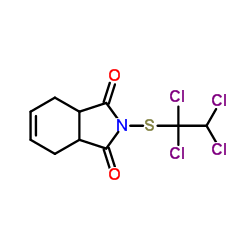敌菌丹
一般危化品

敌菌丹结构式
|
常用名 | 敌菌丹 | 英文名 | Captafol |
|---|---|---|---|---|
| CAS号 | 2425-06-1 | 分子量 | 349.061 | |
| 密度 | 1.6±0.1 g/cm3 | 沸点 | 365.7±52.0 °C at 760 mmHg | |
| 分子式 | C10H9Cl4NO2S | 熔点 | 160-161° | |
| MSDS | 中文版 美版 | 闪点 | 175.0±30.7 °C | |
| 符号 |



GHS07, GHS08, GHS09 |
信号词 | Danger |
敌菌丹用途用来防治番茄叶和果实的病害、马铃薯枯萎病等。制剂有80%可湿性粉剂和40%悬浮剂。 |
| 中文名 | 敌菌丹 |
|---|---|
| 英文名 | captafol |
| 中文别名 | N-(1,1,2,2,-四氯乙硫基)-4-环已烯-1,2-二甲酰亚胺 | 四氯丹 |
| 英文别名 | 更多 |
| 密度 | 1.6±0.1 g/cm3 |
|---|---|
| 沸点 | 365.7±52.0 °C at 760 mmHg |
| 熔点 | 160-161° |
| 分子式 | C10H9Cl4NO2S |
| 分子量 | 349.061 |
| 闪点 | 175.0±30.7 °C |
| 精确质量 | 346.910797 |
| PSA | 62.68000 |
| LogP | 2.40 |
| InChIKey | JHRWWRDRBPCWTF-UHFFFAOYSA-N |
| SMILES | O=C1C2CC=CCC2C(=O)N1SC(Cl)(Cl)C(Cl)Cl |
| 蒸汽压 | 0.0±0.8 mmHg at 25°C |
| 折射率 | 1.629 |
| 储存条件 | 密封保存 |
| 稳定性 | 常温常压下稳定酸性和碱性条件下不稳定,在熔点温度时缓慢分解 |
| 分子结构 | 1、 摩尔折射率:75.57 2、 摩尔体积(m3/mol):212.7 3、 等张比容(90.2K):594.0 4、 表面张力(dyne/cm):60.7 5、 极化率(10 -24cm 3):29.96 |
| 计算化学 | 1、 疏水参数计算参考值(XlogP):3.8 2、 氢键供体数量:0 3、 氢键受体数量:2 4、 可旋转化学键数量:3 5、 互变异构体数量:3 6、 拓扑分子极性表面积(TPSA):37.4 7、 重原子数量:18 8、 表面电荷:0 9、 复杂度:387 10、同位素原子数量:0 11、确定原子立构中心数量:0 12、不确定原子立构中心数量:2 13、确定化学键立构中心数量:0 14、不确定化学键立构中心数量:0 15、共价键单元数量:1 |
| 更多 | 1. 性状:无色结晶固体 2. 密度(g/mL, ,25℃):未确定 3. 相对蒸汽密度(g/mL,空气=1):未确定 4. 熔点(ºC):160-161 5. 沸点(ºC,常压):未确定 6. 沸点(ºC 5mmHg):未确定 7. 折射率(nD20):未确定 8. 闪点(ºC):未确定 9. 比旋光度():未确定 10. 自燃点或引燃温度(ºC):未确定 11. 蒸气压(Pa,20ºC):未确定 12. 饱和蒸气压(kPa, 0ºC):未确定 13. 燃烧热(KJ/mol):未确定 14. 临界温度(ºC):未确定 15. 临界压力(KPa):未确定 16. 油水(辛醇/水)分配系数的对数值:未确定 17. 爆炸上限(%,V/V):未确定 18. 爆炸下限(%,V/V):未确定 19. 溶解性:难溶于水(1.4mg/L),微溶于大多数有机溶剂。 |
| 符号 |



GHS07, GHS08, GHS09 |
|---|---|
| 信号词 | Danger |
| 危害声明 | H317-H350-H410 |
| 警示性声明 | P201-P273-P280-P308 + P313-P501 |
| 个人防护装备 | Eyeshields;Faceshields;full-face particle respirator type N100 (US);Gloves;respirator cartridge type N100 (US);type P1 (EN143) respirator filter;type P3 (EN 143) respirator cartridges |
| 危害码 (欧洲) | T,N |
| 风险声明 (欧洲) | 45-43-50/53 |
| 安全声明 (欧洲) | S45;S53;S60;S61 |
| 危险品运输编码 | UN3077 9/PG 3 |
| RTECS号 | GW4900000 |
由丁二烯与顺丁烯二酸酐反应后,再与氨,ClSCCl2CHCl2反应,即制得本品。
|
DNA damage and micronuclei induced in rat and human kidney cells by six chemicals carcinogenic to the rat kidney.
Toxicology 204(2-3) , 187-95, (2004) Six chemicals, known to induce kidney tumors in rats, were examined for their ability to induce DNA fragmentation and formation of micronuclei in primary cultures of rat and human kidney cells, and in... |
|
|
Captafol.
Rep. Carcinog. 12 , 83-6, (2011)
|
|
|
[Determination of captafol, cyhexatin, 1-naphthylacetic acid and quintozene in apple, Japanese pear and melon by simultaneous extraction].
Shokuhin Eiseigaku Zasshi 44(2) , 126-31, (2003) A simple and rapid method is described for the determination of the non-registered pesticides, captafol, quintozene (PCNB), cyhexatin and 1-naphthylacetic acid (NAA), in fruits. These pesticides were ... |
| 3a,4,7,7a-tetrahydro-N-(1,1,2,2-tetrachloroethanesulfenyl)phthalimide |
| FOLTAF |
| Captatol |
| 2-(1,1,2,2-tetrachloro-ethylsulfanyl)-3a,4,7,7a-tetrahydro-isoindole-1,3-dione |
| haipen |
| EINECS 219-363-3 |
| N-(1,1,2,2-tetrachloroethylthio)-1,2,3,6-tetrahydrophthalimide |
| N-(1,1,2,2-tetrachloroethylthio)cyclohex-4-ene-1,2-dicarboximide |
| Sanspor |
| cs5623 |
| 2-[(1,1,2,2-Tetrachloroethyl)sulfanyl]-3a,4,7,7a-tetrahydro-1H-isoindole-1,3(2H)-dione |
| Difosan |
| 3a,4,7,7a-tetrahydro-2-[(1,1,2,2-tetrachloroethyl)thio]-1H-isoindole-1,3(2H)-dione |
| Captofol |
| 1H-Isoindole-1,3(2H)-dione, 3a,4,7,7a-tetrahydro-2-[(1,1,2,2-tetrachloroethyl)thio]- |
| MFCD00041816 |
| Folcid |
| 3a,4,7,7a-Tetrahydro-2-((1,1,2,2-tetrachloroethyl)thio)-1H-isoindole-1,3(2H)-dione (9CI) |
| Captafol |
| kenofol |
